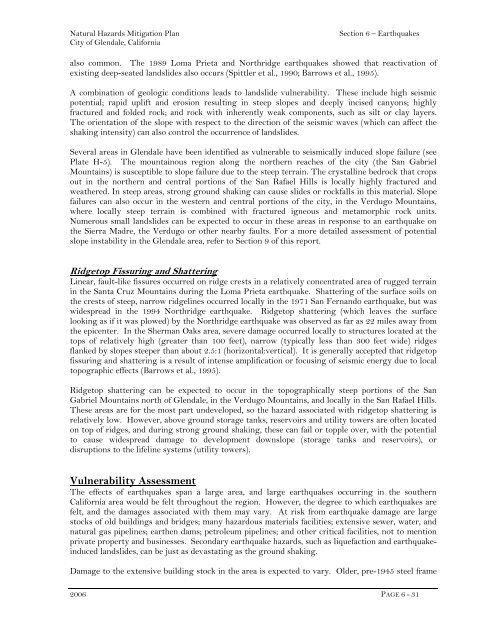Glendale (PDF) - Hazard Mitigation Web Portal - State of California
Glendale (PDF) - Hazard Mitigation Web Portal - State of California
Glendale (PDF) - Hazard Mitigation Web Portal - State of California
- No tags were found...
Create successful ePaper yourself
Turn your PDF publications into a flip-book with our unique Google optimized e-Paper software.
Natural <strong>Hazard</strong>s <strong>Mitigation</strong> PlanCity <strong>of</strong> <strong>Glendale</strong>, <strong>California</strong>Section 6 – Earthquakesalso common. The 1989 Loma Prieta and Northridge earthquakes showed that reactivation <strong>of</strong>existing deep-seated landslides also occurs (Spittler et al., 1990; Barrows et al., 1995).A combination <strong>of</strong> geologic conditions leads to landslide vulnerability. These include high seismicpotential; rapid uplift and erosion resulting in steep slopes and deeply incised canyons; highlyfractured and folded rock; and rock with inherently weak components, such as silt or clay layers.The orientation <strong>of</strong> the slope with respect to the direction <strong>of</strong> the seismic waves (which can affect theshaking intensity) can also control the occurrence <strong>of</strong> landslides.Several areas in <strong>Glendale</strong> have been identified as vulnerable to seismically induced slope failure (seePlate H-5). The mountainous region along the northern reaches <strong>of</strong> the city (the San GabrielMountains) is susceptible to slope failure due to the steep terrain. The crystalline bedrock that cropsout in the northern and central portions <strong>of</strong> the San Rafael Hills is locally highly fractured andweathered. In steep areas, strong ground shaking can cause slides or rockfalls in this material. Slopefailures can also occur in the western and central portions <strong>of</strong> the city, in the Verdugo Mountains,where locally steep terrain is combined with fractured igneous and metamorphic rock units.Numerous small landslides can be expected to occur in these areas in response to an earthquake onthe Sierra Madre, the Verdugo or other nearby faults. For a more detailed assessment <strong>of</strong> potentialslope instability in the <strong>Glendale</strong> area, refer to Section 9 <strong>of</strong> this report.Ridgetop Fissuring and ShatteringLinear, fault-like fissures occurred on ridge crests in a relatively concentrated area <strong>of</strong> rugged terrainin the Santa Cruz Mountains during the Loma Prieta earthquake. Shattering <strong>of</strong> the surface soils onthe crests <strong>of</strong> steep, narrow ridgelines occurred locally in the 1971 San Fernando earthquake, but waswidespread in the 1994 Northridge earthquake. Ridgetop shattering (which leaves the surfacelooking as if it was plowed) by the Northridge earthquake was observed as far as 22 miles away fromthe epicenter. In the Sherman Oaks area, severe damage occurred locally to structures located at thetops <strong>of</strong> relatively high (greater than 100 feet), narrow (typically less than 300 feet wide) ridgesflanked by slopes steeper than about 2.5:1 (horizontal:vertical). It is generally accepted that ridgetopfissuring and shattering is a result <strong>of</strong> intense amplification or focusing <strong>of</strong> seismic energy due to localtopographic effects (Barrows et al., 1995).Ridgetop shattering can be expected to occur in the topographically steep portions <strong>of</strong> the SanGabriel Mountains north <strong>of</strong> <strong>Glendale</strong>, in the Verdugo Mountains, and locally in the San Rafael Hills.These areas are for the most part undeveloped, so the hazard associated with ridgetop shattering isrelatively low. However, above ground storage tanks, reservoirs and utility towers are <strong>of</strong>ten locatedon top <strong>of</strong> ridges, and during strong ground shaking, these can fail or topple over, with the potentialto cause widespread damage to development downslope (storage tanks and reservoirs), ordisruptions to the lifeline systems (utility towers).Vulnerability AssessmentThe effects <strong>of</strong> earthquakes span a large area, and large earthquakes occurring in the southern<strong>California</strong> area would be felt throughout the region. However, the degree to which earthquakes arefelt, and the damages associated with them may vary. At risk from earthquake damage are largestocks <strong>of</strong> old buildings and bridges; many hazardous materials facilities; extensive sewer, water, andnatural gas pipelines; earthen dams; petroleum pipelines; and other critical facilities, not to mentionprivate property and businesses. Secondary earthquake hazards, such as liquefaction and earthquakeinducedlandslides, can be just as devastating as the ground shaking.Damage to the extensive building stock in the area is expected to vary. Older, pre-1945 steel frame2006 PAGE 6 - 31
















